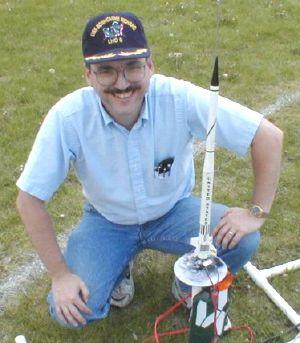| Construction Rating: | starstarstarstarstar_border |
| Flight Rating: | starstarstarstarstar |
| Overall Rating: | starstarstarstarstar_border |
| Manufacturer: | Estes  |
| Style: | Scale-Like |
 Brief:
Brief:
(from the 1971 Estes catalog) An excellent scale-like model for any rocketeer. A new feature is the integral fin unit-engine mount providing immediate and positive location of the thrust rings. The embossed metallic press-on material and decal arrangement add the final professional touch of realism not found in other models of its class.
Modifications:
Launch lugs mounted to a dowel for rail support. Upgraded shock cord.
Construction:
The construction of this rocket was pretty easy. The unique aspects were that molded plastic parts back then usually came in halves that had to be glued together. Therefore, the fin can, transition and nose cone all had to be glued together with plastic model cement, and there are mold lines on all three of these parts. The engine mount fit tight into the fin can and was also glued with white glue and plastic cement. One deviation I did was to put the launch lugs on a wood dowel so that the rocket could be optionally launched on a traditional rod or a C-rail (which was also available from Estes for more realistic looking launch pads).
Finishing:
A coat of white spray paint and then the nose cone painted black was all the painting necessary. I would have a done a better job now, but this is a good reference point on what to expect of a boy building his third or fourth rocket with no input from his Dad. The decals are all water transfer except for the metallic bands on the fin can. They were very sticky and one got put on out of alignment and could not be reapplied.
Construction Rating: 4 out of 5

Flight:
This rocket flies straight and fast every time. It has flown on A8-3, B6-4, B8-5, B4-4, B6-6, and C6-5. On its fourth flight the weakened payload body tube bent in the middle from the acceleration. The flight was erratic because of that. This was repaired with another body tube glued into the inside as stiffener.
Recovery:
The rocket recovers fine on a 12 inch orange chute. The nose cone was lost off the payload bay on the first flight because it was only held on with light friction. This was a good but undesirable lesson learned with nose cones on payload bays. The nose cone had some unique features not easily duplicated. It has been replaced with a balsa nose cone. The original rubber shock cord has been replaced with a modern elastic cord.
Flight Rating: 5 out of 5
Summary:
Rocket History: This was one of only two rockets that my Mom saved and did not give or throw away. I had finished it but never flown it. In fact, it still had a B6-4 prepped with the old nichrome wire igniter and little ball of cotton installed after all those years in our basement in Colorado. I probably had tried to fly it, but the old red 8 D cell launch pad had let me down again, and I gave up model rocketry in disgust. Taking it home from a vacation with my 6-year old son and 8-year old daughter caused me to become a BAR when I bought a Goliath/Spitfire starter kit to obtain a launcher. This rocket had a maiden flight 25 years after it was built, and has flown many times since. I lost the unique plastic nose cone on the first flight. SAROS was taking a Polly Pocket for a ride in the payload bay. The nose cone fell down somewhere in the weeds never to be found. Polly stayed in the payload bay and didn't come out for a few years because she was stuck (or traumatized).
Overall Rating: 4.5 out of 5
 |
 |
Flights
Sponsored Ads
 |
 |











